1. Introduction
Consumers’ growing concern for health and nutrition has increased the market potential for functional foods worldwide. Many studies have shown that fortified food products positively affect health (Maji et al., 2020). Functional foods are foods that may positively affect health beyond basic nutrition and help reduce disease risk. They are usually enriched with different antioxidant compounds (such as polyphenols, carotenoids, terpenes, and terpenoids), fibers, vitamins and minerals, phytosterols, omega-3 fatty acids, and probiotics. Functional beverages on the market can be categorized as follows: (1) dairy beverages containing probiotics and minerals and ω-3-enriched beverages, (2) vegetable and fruit beverages, and (3) energy and sports beverages. Much research has addressed the application of different functional drinks, such as pro/prebiotic and fiber-based functional drinks (Arya and Shakya, 2021; Kokwar et al., 2022; Raman et al., 2019). Apple fruit (Malus domestica Borkh) is one of the most well-known fruits in the world market, and its consumption is very common in many countries due to its high nutritional properties. Apple is one of the important sources of polyphenol compounds, which has a vital effect in preventing many diseases such as lung cancer, type 2 diabetes, asthma or thrombotic stroke, and ischemic heart disease (Wojdyło and Oszmiański, 2020).
Dietary fiber has shown unique properties in maintaining health and preventing disease. Eating foods rich in this diet can decrease total plasma and LDL cholesterol, reduce glycemic and insulin response, increase stool bulk, and improve laxation (Gill et al., 2021). In recent years, low-calorie and rich-nutritional ingredients foods have been identified as part of the daily diet of consumers. Among them, polycostorose is introduced as a source of prebiotic-soluble food in drinks and foods worldwide (Wang et al., 2014). Polydextrose contains 90 g/100 g soluble fiber and only 1 kcal per gram of energy. This polysaccharide is composed of randomly cross-linked glucose and is indigestible (Alptekin et al., 2022). Due to its good processing performance and potential health benefits, it has been introduced as a low-calorie bulk ingredient in various foods and a partial substitute for fat and sugar (Veena et al., 2016). Inulin is increasingly used in processed foods as a fat or sugar substitute or to enhance product properties and has only 25-35 g/100 g of energy compared to digestible carbohydrates (Mudannayake et al., 2022). As a special food ingredient, inulin has shown many important dietary benefits and specific industrial properties for its widespread use in food applications (Ahmed and Rashid, 2019). Dietary fiber is now recognized as a vital element for improving human health, and the importance of dietary fiber-rich foods is increasing daily due to their health-giving properties (Shoaib et al., 2016).
The seeds of the cardamom plant (Elettaria cardamomum) (family Zingiberaceae) are available as a real or true cardamom. Cardamom has been introduced as the queen of spices due to its pleasant aroma, versatile flavoring for many foods and drinks, and multiple uses in local treatments. Cardamom is used commercially in perfumes and as a flavoring in the food industry to be used in the formulation of baked products, soups, meats, jellies, fruit products, and pickles (Singletary, 2022). The main volatile compounds in cardamom essential oil (CEO) are α-thipinyl acetate and 1,8-cineol (Anwar et al., 2016). Ginger rhizomes have many advantages for human health, including anti-inflammatory, stimulant, perfume or spice, circulation, cholesterol-lowering, blood pressure, diaphragm and anti-vomiting (cough), anti-inflammatory and increased appetite (Pamela et al., 2021). For years, ginger has been an essential part of most traditional herbal medicines in Africa, China, and India for the management/treatment of ailments such as colds, headaches, muscle aches, arthritis, gingivitis, neurological diseases, asthma, and toothaches (Li et al., 2019). Ginger’s health benefits are attributed to the extraordinary amount of its various phenolic compounds, including ginger, paradals, shoglales and zingron (Srinivasan et al., 2017), as well as dihydroparadols, 3-dihydroshogaols, acetylated gingerol derivatives, diaryl heptanoids, gingerdiols, and ferulic acid derivates (Nutakor et al., 2020).
In the most recent similar research, Hassanzadeh et al. (2022) investigated the physicochemical characteristics of a high-protein functional drink enriched with spirulina-wheat germ based on pear-melon juice and stated that spirulina algae and wheat germ powder could significantly increase the nutritional value of pear-melon juice so that the content of protein, minerals, and essential fatty acids is also increased. The simultaneous use of processed essential oil with water solubility, plant extract, and prebiotic dietary fibers in fresh apple juice are new aspects of this project. Due to the high popularity of apple juice worldwide and its nature for enrichment with various nutrients, including fibers and plant extracts, this research attempted to formulate a product with antioxidant properties and high sensory properties based on natural ingredients. Based on this fact, the current research aimed to evaluate the simultaneous application of dietary prebiotic fibers (inulin and polydextrose) and high polyphenol content herbal ingredient [ginger extract (GE) and CEO] for the enrichment of the fresh apple juice and to measure their effects on the organoleptic, physicochemical and rheological characteristics of the formulated functional juice.
2. Materials and methods
Inulin and polydextrose were purchased from a Takdaneh industry in Marand, Iran. Zrdband Co prepared the processed extracts of ginger and cardamom. Also, DPPH (2,2-diphenyl-1-picrylhydrazyl) was purchased from Sigma-Alddrich to measure the antioxidant capacity (Burlington, MA, USA).
The fresh apple juice was prepared by pressing the apple fruit with a juicer for several minutes; the total soluble solids of the juice were measured at 20°C using a refractometer. Finally, the juice was pasteurized at 85°C for 10 min, packaged into a low-density polyethylene bag, and stored at 4°C until use.
Ascorbic acid was measured by molecular absorption spectrophotometry using a spectrophotometer (1601 PC UV-visible, Shimadzu Corporation, Kyoto, Japan) (Porto et al., 2019).
A refractometer (Atago, Minato-ku, Japan) and pH meter (OHAUS, Parsippany, NJ, USA) were used for measuring the total soluble solids (°Brix) and pH value. To determine titratable acidity, 50 mL of distilled water was mixed with the specified volume of each sample in a 250 mL beaker. In the next stage, the prepared mixture was titrated with standard 0.1 N NaOH until purple appeared (pH 8.2±0.1). Based on the method of Sadler and Murphy (2010), the content of citric acid per 100 mL of apple juice was determined by the volume of NaOH, and finally, the total acidity (g/100 g TA) was calculated by the following equation:
In the above equation, V is NaOH’s titer volume, and VS is the apple juice sample’s volume. The FI (g/100 g of fruit juice), total sugars, and reducing sugars in fruit juices were measured by Iranian standards based on Lane-Inon measurement (Ghasemi et al., 2019).
The antioxidant activity was evaluated by DPPH free radical, based on the method proposed by Viacava and Roura (2015). In practice, an ethanolic DPPH solution (100 mM) was prepared for determination. A known volume (3.9 mL) of DPPH (100 mM) was mixed with ethanol (0.1 mL) to calculate the initial absorbance of the DPPH solution. In the next step, 0.1 mL of fruit juice sample was mixed with 3.9 mL of 100 mM DPPH solution. The prepared mixture was immediately shaken and left for 60 min at room temperature in the dark, and then the decrease in absorbance was recorded at 517 nm (Hassanzadeh et al., 2022). The antioxidant capacity of the juice samples against DPPH free radicals was calculated as described by Gyamfi et al. (1999).
Where A0is the absorbance of control samples, and AS is the absorbance of measured samples (Hassanzadeh et al., 2017; Hassanzadeh et al., 2019).
The TPC was calculated by Foline Ciocalteu reagent based on the spectrophotometer methodology described by Viacava and Roura (2015) with some modifications. 1,000 mL of FCR (diluted 1/10) were mixed with some diluted samples. 800 mL of Na2CO3 solution (7.5 g/100 g) was mixed with the previous solution after 3 min of incubation at ambient temperature, and the reaction mixture was incubated for 2 h at the same temperature. The absorbance was recorded using a UV-Vis spectrophotometer (1601 PC UV-visible, Shimadzu Corporation) at 765 nm, and TPC was determined by gallic acid as standard. Finally, results were presented as mg of gallic acid equivalents (GAE)/100 mL of product (Cassani et al., 2016).
The total flavonoid content of juice samples was measured based on the method introduced by Yang et al. (2007). 1.25 mL of distilled water and 75 mL of NaNO2 (5 g/100 g) were mixed with the sample (250 mL of 1:10 dilution of a juice sample or 250 mL of 1 mg/mL apple juice in 30 g/100 g methanol). After 5 min, 150 mL of AlCl3 (10 g/100 g) was mixed with the previous solution and allowed to react for 6 min, and after that, 500 μL of NaOH (1 M) was also mixed. Distilled water was used to adjust the final volume to 3 mL. After mixing the prepared solution, the absorbance was recorded at 510 nm compared to the blank instantly using a UV-visible spectrophotometer ((UV1601, Shimadzu Scientific Instruments (Oceania) Pty. Ltd., Rydalmere, Australia)). A standard curve was drawn by Catechin (10-750 mg/mL) (Nanasombat et al, 2015).
The steady-state shear test was measured by a Physica MCR301 rheometer (Anton Paar, Ostfildern, Germany) equipped with a Couette flow cell (Ref. DG27/T2000/SS). By a Peltier system and a Viscotherm VT 2 circulating fluid, which is directly controlled by Physica MCR, the temperature of the tested samples reached 20±0.1°C. Each sample (25 mL), after 5 min of thermal stabilization, was submitted for flow testing in the shear rate range of 0 to 100 s−1 (Laux et al., 2013).
Rheological analyses were performed by a stress-controlled rheometer (Anton Paar) equipped with a Cuette flow cell (Ref. DG27/T2000/SS) at a constant temperature (20±1°C). 25 mL of water sample was used for the fluctuating test. In all experiments, it was used, and the samples were covered with paraffin oil to prevent water loss. The frequency sweep was measured with oscillation frequencies from 0.1 to 100 rad/s, and then the storage modulus (G′) and loss modulus (G″) were measured as a function of frequency.
A hedonic test containing 10 points (1-10 for very bad to excellent, respectively) was used for the sensory evaluation of juice samples. The panelists scored sensory characteristics, including color, appearance, taste/flavor, mouthfeel, and total acceptance (n=25) (Renuka et al., 2009; Hassanzadeh et al., 2018). Appropriate protocols for protecting the rights and privacy of all participants were utilized during the execution of this research. This sensory evaluation was conducted safely and with final exemption from the Ilam University Institutional Review Board (IRB) (Approval number: ILU-2022-0278).
In the screening stage, a combined D-optimal design by Design Expert software (version 10) was used to optimize prepared samples. In the second stage, the selected samples were prepared by a randomized complete design and analyzed by one-way analysis of variance (ANOVA) using Minitab (version 17, Pennsylvania State University, PA, USA), and all data was recorded as mean±standard deviation (SD) of three replicates. Tukey test was used for the comparison of mean treatments (α=0.05).
3. Result and discussion
At this stage, the data obtained from sensory evaluation was collected and statistically analyzed in the framework of the experimental design by Design Expert software (version 10) (Table 1). The software has determined the optimal point of response and the levels of the studied factors to achieve the optimal point based on the numerical method (Hassanzadeh et al., 2016).
Sensory properties are one of the most important quality factors in developing and formulating functional food products to provide important information about their most desirable attributes (Granato et al., 2010). The optimization based on sensory properties was performed to identify the effects of adding plant extract, essential oil, and dietary fiber on the sensory attributes of the fresh apple juice (possible negative effects on the taste, color, and smell of the product) and also to find the appropriate dose range of these plant extract and essential oil. The sample containing 0.25 g/L ginger, 0.03 g/100 g cardamom, and inulin was identified as the optimal sensory sample (OOP) and selected for the next stage (Table 2).
| Samples | Factor 1: GE (g/100g) | Factor 2: CEO (g/100g) | Factor 3: Fiber type |
|---|---|---|---|
| POL1) | 0 | 0 | Polydextrose |
| CEO | 0 | 0.05 | None |
| OOP | 0.25 | 0.03 | Inulin |
| AOP (GE) | 0.5 | 0 | None |
| INU | 0 | 0 | Inulin |
The results related to the physical properties of the produced functional juices showed that there was no statistically significant difference in the pH and acidity of the samples. It showed that none of the added compounds, including fiber (inulin and polydextrose), plant extract (GE), and essential oil (CEO), caused a change in the acidity of the produced products. However, the effects of the studied factors on the Brix were significant, and the addition of both inulin and polydextrose (3 g/100 g) increased it from 10 to 12.6 (Table 3). Similar results were observed by Hosseini et al. (2016), who reported that adding inulin to apple juice increased the brix.
The FI, an indicator for measuring the percentage of fruit in the juice, was not significantly affected by the studied factors, and a fixed value of FI was obtained to be 0.8 for all juice samples prepared in the second stage. Indeed, this indicator, which indirectly shows the amount of protein and nitrogen-containing compounds in the juice, confirms that the additives in this study were not protein in nature and did not change the FI (Table 3). In this regard, Hosseini et al. (2016) produced synbiotic industrial apple juice and reported that adding inulin to apple juice alone did not significantly affect the FI.
The effect of GE, CEO, and prebiotic fibers (inulin and polydextrose) were investigated on the total phenol content of the five selected functional beverage samples, including the optimal samples in the first stage (based on sensory and antioxidant properties). According to Fig. 1, adding the GE and, to some extent, CEO increased the amount of total phenol, while both prebiotic fibers did not have a significant effect. The highest amount of total phenol (480 mg GAE/g) was observed in the GE sample (0.5 g/100 g ginger). As shown in Fig 1, adding GE to the fresh apple juices increased the total phenol content from about 350 mg GAE/g to 480 mg GAE/g, respectively. The OOP sample (0.25 g/100 g of GE and 0.03 g of CEO), the optimal sample based on organoleptic evaluation, also had relatively high total phenol content (440 mg GAE/g).
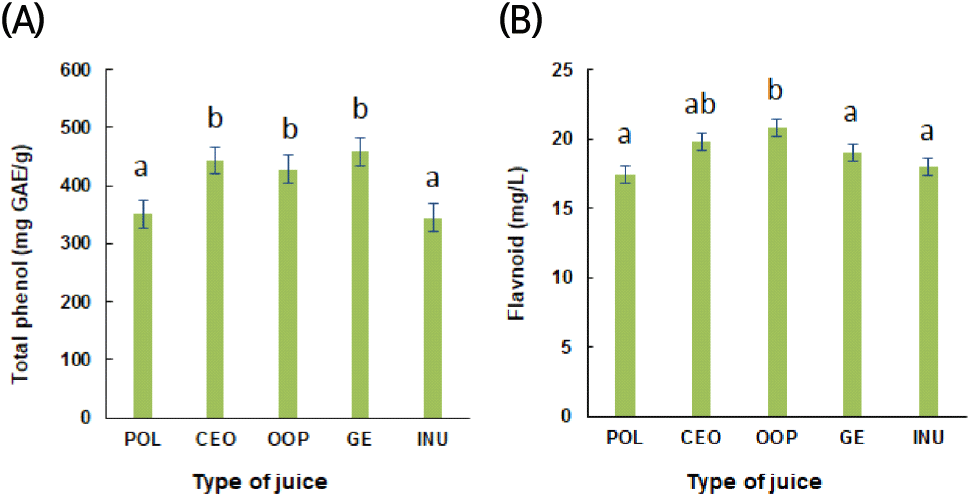
In similar attempts, Saad et al. (2021) produced functional cucumber juices enriched with herbal extracts (cinnamon, mint, ginger, and clove), and they reported that the juices enriched by clove and followed by mint were the richest samples from the point of the phenolic and flavonoid compounds in compared to the control one. Sarvarian et al. (2022) designed the orange juice enriched with various oleaster (Elaeagnus angustifoliaL.) extract concentrations. They reported that adding 20 and 25 g/100 g aqueous and 5 g/100 g alcoholic oleaster extracts increased the orange-juice-based beverages’ free radical scavenging capacity and total phenolic content. Hashemi et al. (2018) also announced that the phenolic compounds and antioxidant capacity are increased by adding oleifera leaf extract to the orange juice.
Flavonoids are the largest phenolic compounds in many extracts and spices, which can be used to produce healthy, functional foods and beverages (Pamela et al., 2021). As shown in Fig. 2, although the results of flavonoid measurement are similar to the results of total phenol evaluation, which shows the major phenolic ingredients of extracts are flavonoids; however, the highest amounts of flavonoids were observed in the samples containing GE (p<0.05).
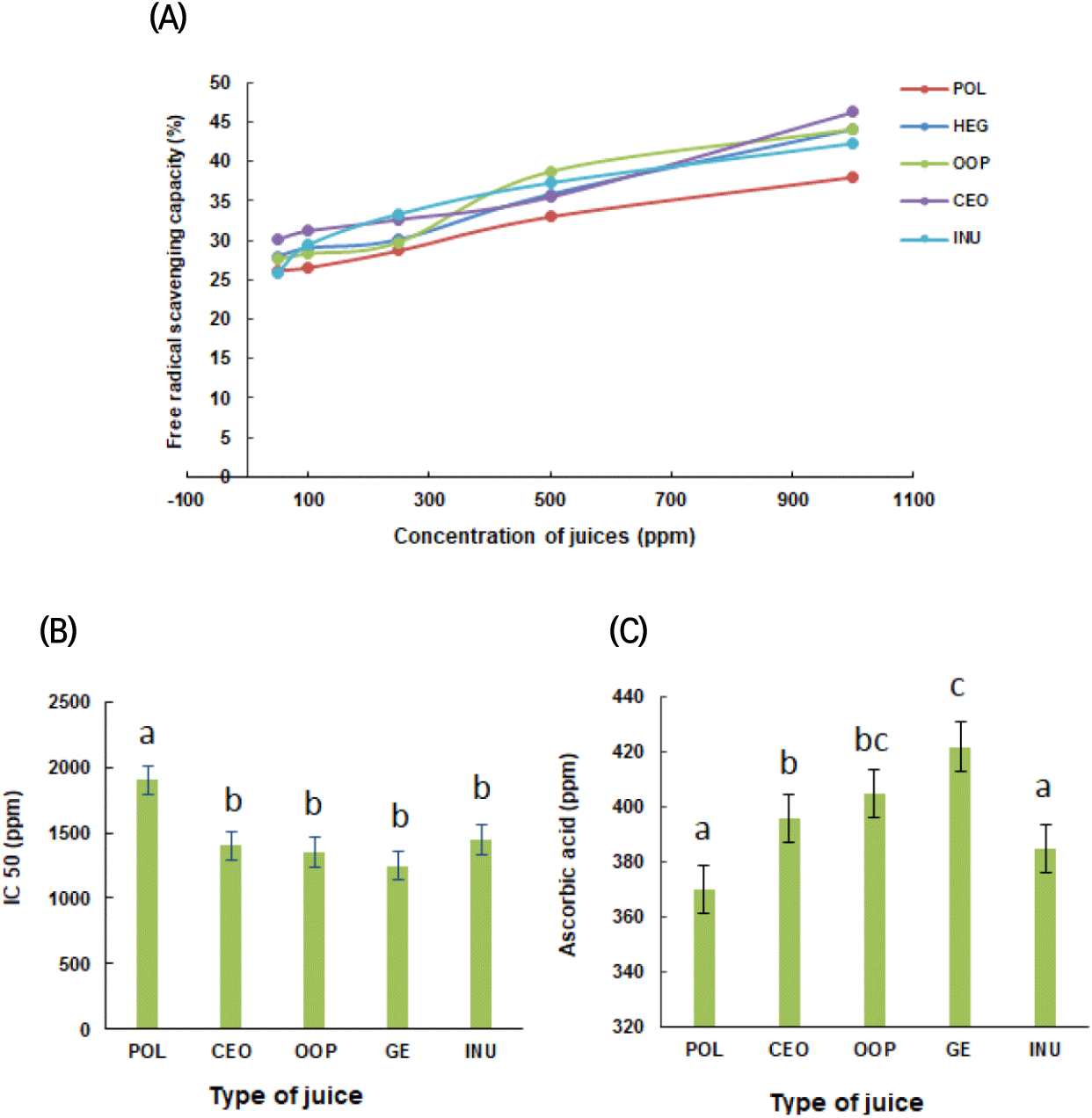
Plant extracts contain bioactive compounds such as polyphenols, terpenes, carotenoids, acid ascorbic etc., which act as antioxidants by donating hydrogen atoms or electrons to neutralize reactive oxygen spices and aid in decreasing lipid oxidation and some diseases (Mošovská et al., 2015). The IC50 is the concentration of an antioxidant-containing substance required to scavenge 50% of the initial DPPH radicals. The lower the IC50 value, the more potent the substance is at scavenging DPPH, which implies a higher antioxidant activity. The results of DPPH antioxidant capacity and IC50 assays for the five tested samples are presented in Fig. 2(A) and (B). These results showed that the juice containing ginger also had the highest amounts of antioxidant capacity (39 g/100 g at 500 mg/kg of juice concentration) and the lowest amount of IC50 (1,300 mg/kg) (p<0.05). The main reason for these results is the presence of large amounts of polyphenols in plant extracts and their ability to neutralize free radicals. GE and oleoresins are rich in phenolic antioxidants such as 6-gingerol, 6-shogaol, and 6-paradol (Dugasani et al., 2010; Rahmani et al., 2014).
In similar research, Grobelna et al. (2019) reported that antioxidant activity in the mixed 10 g/100 g blueberry juice with apple juice was almost three times higher than the pure apple juice after 90 days of storage. In other research work, El-Saadony et al. (2022) tried to apply the herbal extracts of peppermint, basil, lavender, and lemongrass ethanolic extracts to improve the flavor of functional cucumber juice and their results showed that the polyphenols and aroma compounds in the added extracts promoted the antioxidant activity of cucumber juices. In another study, Sarvarian et al. (2022) designed the orange juice enriched by various concentrations of oleaster (Elaeagnus angustifolia L.) extracts. They reported a significant relation between free radical scavenging capacity and total phenolic content and sensory attributes such as color and taste.
Ascorbic acid (vitamin C) is an essential vitamin in the human diet which has an important role as a natural antioxidant and prevents oxidative stress in the body (Zhao et al., 2018). Also, it constitutes dehydroascorbic acid and L-ascorbic acid, an oxidized form of ascorbic acid (Zümreoglu-Karan, 2006). The most important sources of vitamin C are vegetables and fruits, and natural plant extracts can also play an essential role as vitamin C fortifiers (Bochnak-Niedźwiecka and Świeca, 2020).
The vitamin C measurements of the five selected functional juices showed that adding plant extract (GE) and essential oil (CEO) increased vitamin C content. The highest vitamin C was observed in the GE sample, similar to total phenol content and antioxidant capacity. Adding inulin and polydextrose did not significantly affect the amount of vitamin C (p<0.05). Grobelna et al. (2019) reported that vitamin C content was significantly affected by adding blue honeysuckle berry juice to apple juice in the novel-formulated fruit juice. In another research, cucumber juices enriched with herbal extracts (mint, cinnamon, clove, and ginger) showed higher vitamin C content than the control sample (Saad et al., 2021).
The results of steady shear rheological tests showed that all samples had non-Newtonian shear thinning behavior (Fig. 3), which could be attributed to the presence of macromolecules such as protein and polysaccharide in fresh apple juice, GE, and also added inulin and polydextrose. The juices containing GE showed strangely higher apparent viscosity at all ranges of shear rate than the samples containing only prebiotic fibers, which could probably be related to the presence of biopolymeric compounds in added extracts. The sample containing GE and inulin (OOP) had the highest viscosity. Augusto et al. (2011) explained that adding fiber changes the peach juice's flow behavior from Newtonian to pseudo-plastic and Herschel-Bulkley’s behavior. In contrast, Faccin et al. (2009) evaluated a novel rice bran-based beverage’s chemical, sensorial, and rheological properties and introduced Newtonian fluid behavior for the pasteurized rice bran-based beverage.
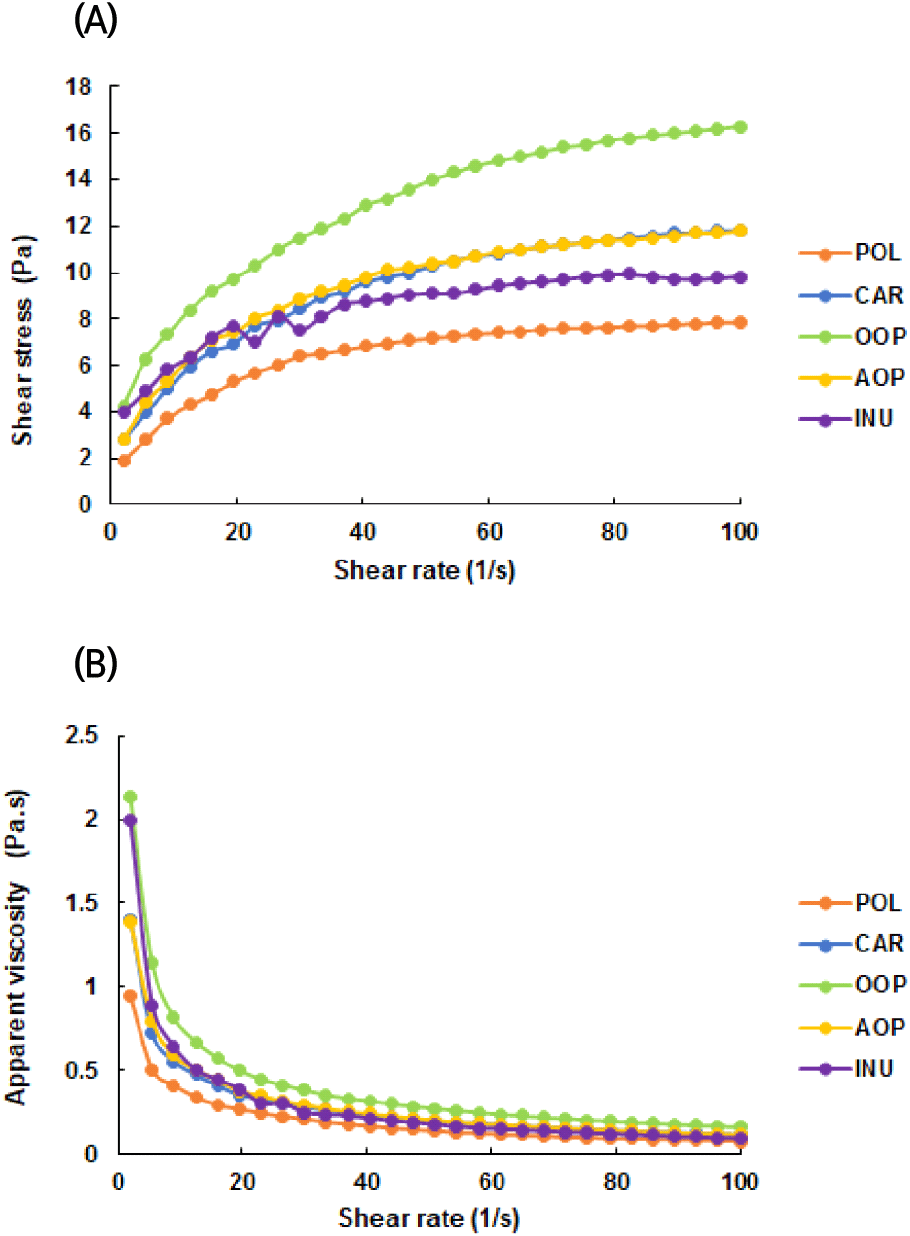
The shear stress versus shear rate data was fitted in the power law model, and parameters of the model, including coefficient of consistency (K) and flow index (n), were calculated. The power law model showed high efficiency (R2=0.95). The apparent viscosities of functional juice samples were also determined at a shear rate of 50 s−1. All samples had n=0.4, showing high non-Newtonian shear thinning properties. The presence of biopolymers (protein and polysaccharides) in fresh apple juice and added extracts, inulin, and polydextrose could lead to shear thinning behavior in fruit juice samples. As shown in Table 4, the highest values of apparent viscosity and consistency index were recorded in the OOP sample which had obtained the highest organoleptic score in the evaluation of the first stage. This shows a direct relationship between the apparent viscosity/consistency index and samples’ sensory score/mouth feel. The sample containing only inulin also had high consistency.
The results of the frequency sweep-oscillatory shear test and diagrams of storage modulus (G′), loss modulus (G″), and complex viscosity (η*) versus frequency are presented in Fig. 4. The results showed that the addition of inulin fiber had a significant effect (p>0.05) on the measured viscoelastic modulus, and the samples containing inulin (OOP and INU) had relatively higher values. However, the addition of polydextrose did not have a significant effect on these parameters (p>0.05). Inulin usually has a higher degree of polymerization and, thus, a higher molecular weight than polydextrose, resulting in higher viscoelastic behavior.
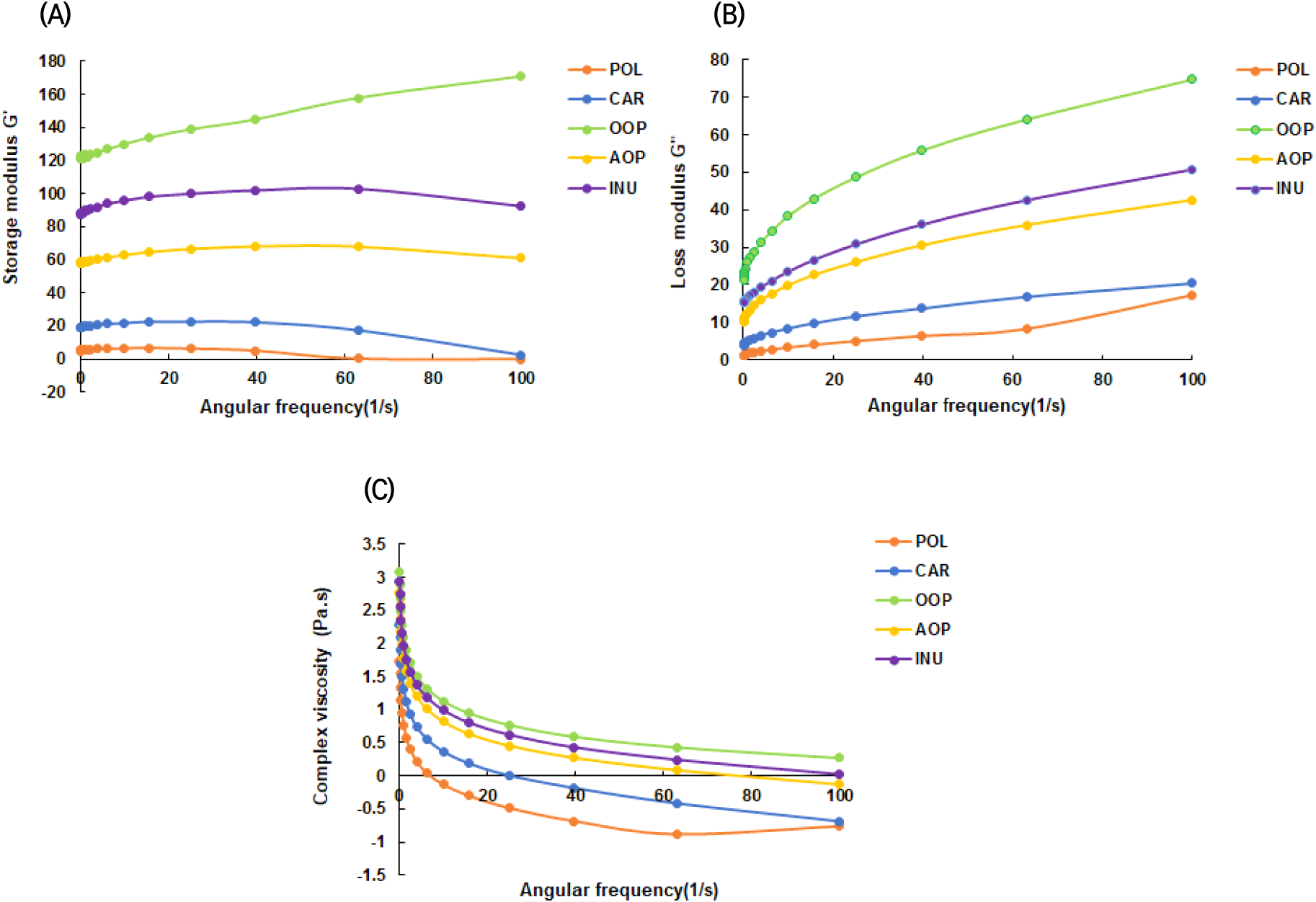
Salinas et al. (2021) reported that adding apple fiber to apple juice increased the elastic character of juice, and the G′ and G″ values were higher for the sample with maximum fiber content. The apple juice samples, containing different fiber concentrations, behaved like viscoelastic fluids with consistently higher magnitudes of storage modulus (G′) than loss modulus (G″) in a frequency sweep.
After sensory evaluation in the first stage and selection of the OOP for further investigation in the second stage, sensory evaluation was performed again for the second-stage samples. As shown in Fig. 5, the OOP sample obtained again the highest score from the panelist for all organoleptic characteristics, including taste, color, odor, mouthfeel, and total acceptance (p<0.05). The results showed that, in general, adding dietary fiber to apple juice has increased the mouth feel and improved the product’s color and, thus, the total acceptance of the product. On the other hand, adding plant extracts and processed essential oils, including ginger and cardamom, respectively, to apple juice has improved the product’s odor, in which cardamom has generally played a greater role. Other researchers have recorded similar reports. For example, Ivanišová et al. (2021) explained that enriched apple juices with water herbal extracts (lemon balm, oregano, and salvia) had better sensory properties for panelists compared to pure apple juice (Ivanišová et al., 2021).
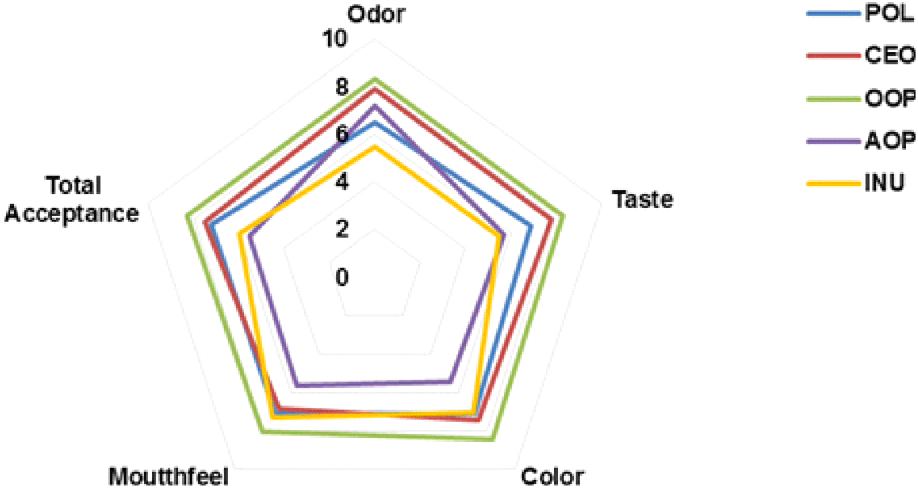
In a similar research, Gunathilake et al. (2013) developed a bioactive-enriched fruit drink targeted for cardioprotection based on a combination of apple, blueberry, and cranberry juice with ginger juice extract and selected amino acids, vitamins, and minerals and reported that up to 2 mL/100 mL of GE can be used in juice formulations without negative effects on sensory properties. Also, Saad et al. (2021) produced a palatable functional cucumber juice enriched with different herbal extracts (cinnamon, mint, ginger, and clove). They reported that the juice containing clove extract obtained the highest sensorial scores (taste and flavor), and also, mint and cinnamon-containing ones had the best color (Saad et al., 2021).
4. Conclusions
In recent years, attention to functional drinks has been increasing significantly, and beverages enriched with various dietary fibers and plant extracts have an important market position. In the present study, the simultaneous use of ginger extract/cardamom essential oil and inulin/polydextrose fibers was considered to enrich fresh apple juice, and their effects were investigated from different aspects. In general, the addition of plant extracts and processed essential oil to apple juice increased the nutritional-nutraceuticals value (total phenol, flavonoids, vitamin C, and antioxidant capacity) and sensory attributes (aroma) of apple juice, but dietary fiber, especially inulin, more affected the rheological properties and sensory properties including mouth feel. This opaque apple juice enriched by dietary prebiotic fibers and plant extracts/essential oil, which also have desirable sensory properties, can be suggested as a more nutritious substitute for clarified apple juice.
